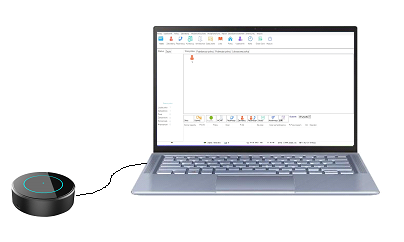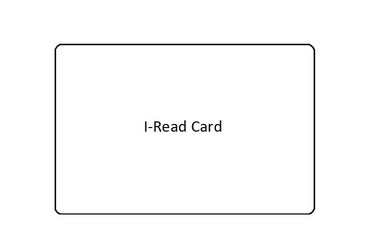System description
Electronic hotel locks are the perfect solution for any facility that wants to increase its prestige and convenience in granting access to hotel rooms. Traditional keys are replaced by modern contactless cards with hotel advertising information. During check-in, a card is issued for the hotel lock, elevator and access to common areas such as the gym, swimming pool or spa. The card is valid only for the time the guest checks in to the hotel, after which it becomes inactive. If the card is lost, the reception will issue another card to the guest, and the old card will be automatically canceled. The system is operated by a convenient and clear program that records all events.
Advantages of hotel locks:
- proximity cards instead of keys ... convenient, fast and modern
- 500 last events stored in the memory of the hotel lock ... access to the room always under control
- one card opens a room, turns on the electricity, operates the elevator etc ... many uses
- battery life up to 2 years ... hotel lock with 1,000,000 openings
- possibility of emergency key opening ... Mastery Key system or one key for one lock
- door open signaling ... conference mode, card stop, do not disturb function
- many other useful features of hotel locks ... check our offer
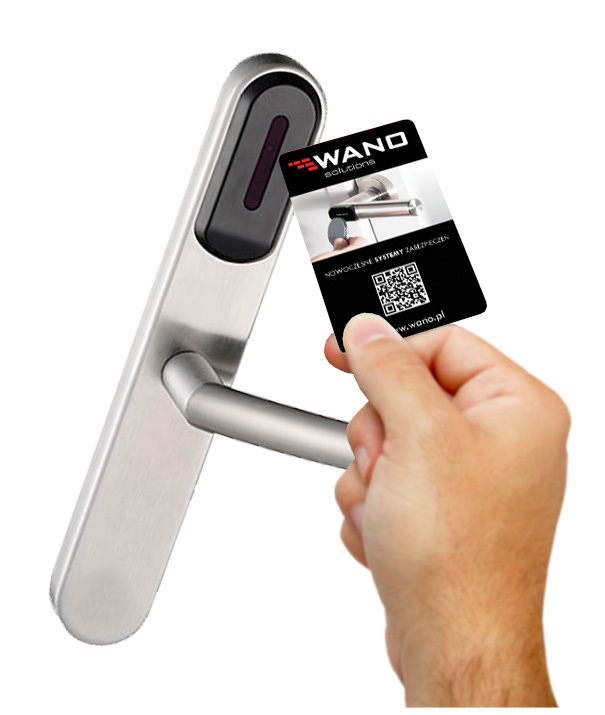
Hotel locks integration
The electronic system of hotel locks can interact with any hotel program on the Polish market. This means that we implement reservations, invoicing and servicing locks from one reception program. The hotel lock system works upwards with Mifare proximity cards which are compatible with access control tests. This allows one card to recreate the hotel's main door, room door, turn on the electricity, wind, elevator or parking barrier. The same cards can be used by opening the locker or at the gate at the entrance to the slope.
Principle of system operation
The principle of the system is based on the use of proximity cards as a key. The reception is equipped with a program for issuing cards, cards - usually with an imprint (e.g. with a hotel logo) and a card programmer. During the guest check-in, the reception issues a hotel room card. The card is only valid for the duration of the guest's stay at the hotel. During this time, each hotel guest, having an active card, can freely move around the facility. One card can serve many rooms, such as SPA or Fitness, as well as an elevator or a pool lock. In order to open the door to his room, the guest has to hold the card close to the reader on the hotel lock plate. The card is read very quickly, approx. 1 sec - after the card is brought closer to the lock by approx. 2 cm. This is followed by an acoustic and optical signal. The handle is activated and you can enter the room. Additionally, the same card can be used to turn on the electricity in the room. After the end of the stay, the hotel guest returns the card to the reception desk. The card becomes inactive and returns to the pool of free cards ready to be used again.
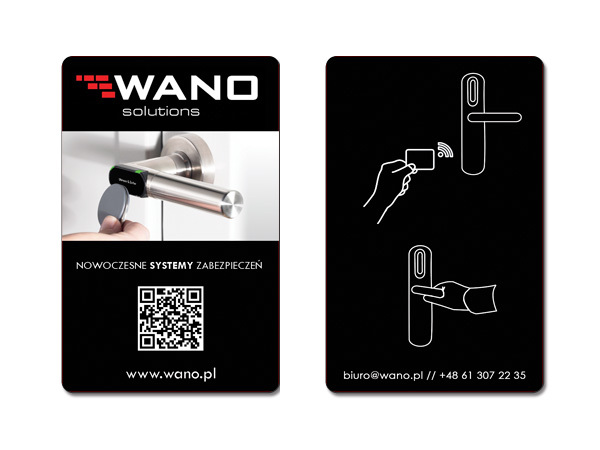
The electronic hotel lock system is a convenient and modern way of granting access to multiple rooms. Only authorized cards can open individual passages. The reception desk decides where and for how long the hotel guest will have access. Cards are difficult to copy, unlike a mechanical key, which gives a high degree of security. In the event of loss or theft of the card, it is enough to block the lock with a blocking card or issue another card to the same users with the "replace old card" function. In contrast, the loss of a mechanical key exposes the user to costly cylinder replacement. If the cards are lost, it just seems to be the next available one. In addition, you do not need to replace the lock, and the cost of a new card is much lower than replacing the cylinder.
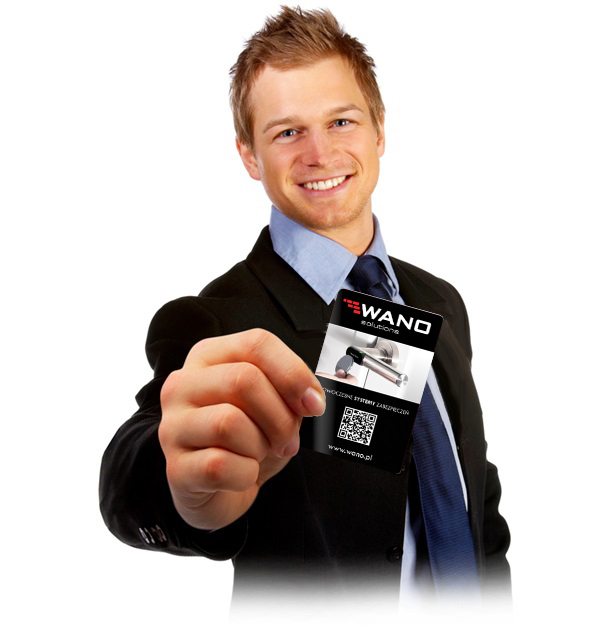
The locks have a built-in, non-volatile FLASH memory that records all activities performed on the hotel lock, i.e. presenting the guest card, master card, wrong card, door failure to close, emergency opening with a key, etc. These events are read using a set of cards with increased capacity or a special device PDA reader. After reading, the events are recorded in the central computer at the reception desk. These events can be viewed and printed.
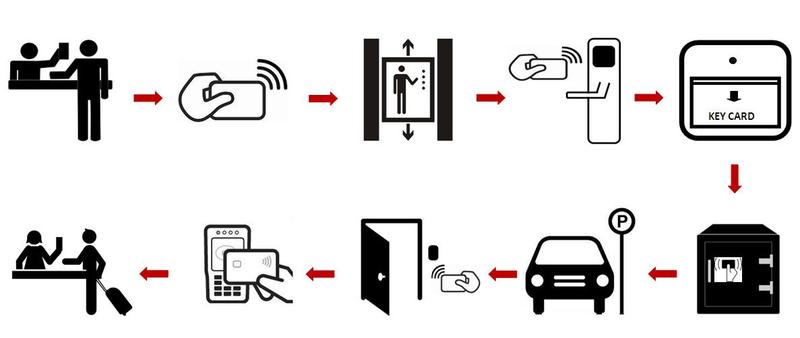
System components:
- electronic lock
- proximity cards with a print (hotel logo, map, advertising, etc.)
- proximity card programmer
- cards with increased capacity or a device for reading event memory from PDA locks (optional)
- software for programming locks and card coding
- energy saving attachment (optional)
Electronic hotel locks
The locks offered by our company work with proximity cards in the Mifare 13.56 MHz technology. The locks are OFFLINE. Card-operated hotel locks do not require external wiring, they are powered by four R6 alkaline batteries - the so-called finger of AA or AA type, which lasts on average from 1.5 to 2 years of operation. Hotel card locks are available as overlay - for existing doors, as well as versions with own mortise lock - for new doors. The hotel lock system can be freely integrated with PMS systems for hotel management.
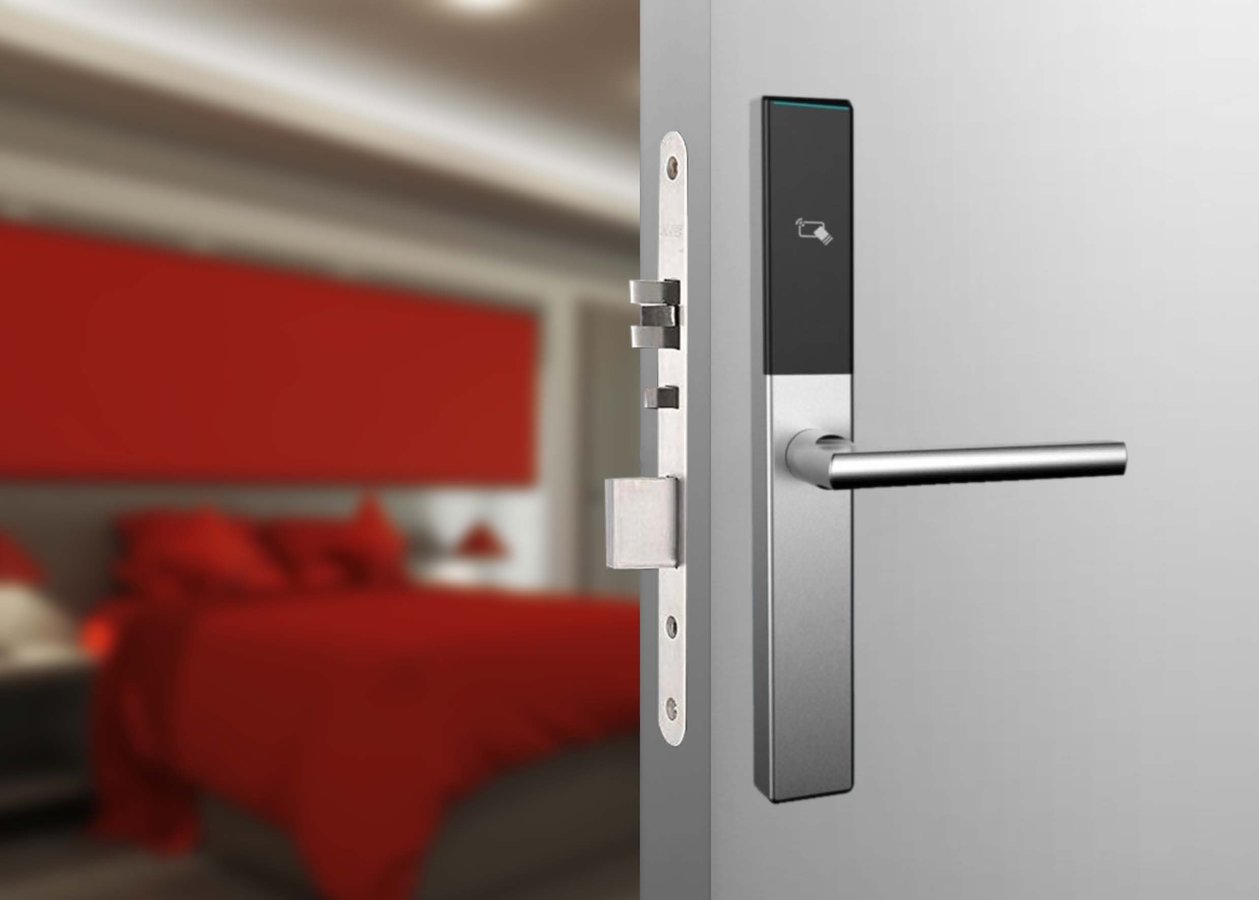
The hotel lock kit includes the following items:
- external signboard with electronics,
- internal sign with a battery compartment,
- mortise lock with a strike plate,
- mechanical cylinder with two keys for emergency opening,
- set of screws and mounting bolts
During "rest", the lock handle located on the outside of the room is inactive. This means that pressing it does not hide the door locking tongues. After applying the proximity card, the mechanism activating the handle is initiated and when it is pressed, the tongues blocking the door hide. We have about 7 seconds to enter the room, after this time the handle is deactivated again. When closing the door, the bolt is automatically blocked and the tongue latch is blocked. The lock from the inside works as ANTI-PANIC, which means that after pressing the internal handle (from the side of the room) you will always be able to get out of the room.
Technical data of the hotel lock:
- power supply: 4 standard AA alkaline batteries (bigger "finger")
- power consumption in standby mode: <15 mA
- current consumption when opening: 150-200 mA
- emergency opening: the door can be opened even with the bolt extended
- battery life: approx. 20,000 openings in normal use, which is enough for approx. 2 years of operation
- opening time: after using the card, it is possible to open it once with the handle within 7 seconds. After this time, the lock will be locked again
- the buzzer in the lock will warn the user if the door is left open for more than 15 seconds
- warning about the need to replace the battery: if the voltage drops below 4.8V, the indicator will turn red when opening. The lock can still be opened dozens of
- times before the battery is completely exhausted
- emergency opening with a key in the Master-Key system or with one key for one lock
- memory up to 500 events
- mortise lock resistance to 1,000,000 openings
- the lock in the version with a mortise lock case or as an overlay on the door used by the hotel
All events, door openings, times and cards used to open the door are stored in the lock. This data can be collected from the lock on a special PDA device or a set of cards with increased capacity and transferred to the computer at the reception desk. The lock buffer contains the most recent 500 events, including those using a mechanical key, as detailed. This function can be especially useful in the event of theft - to recreate the history of events.
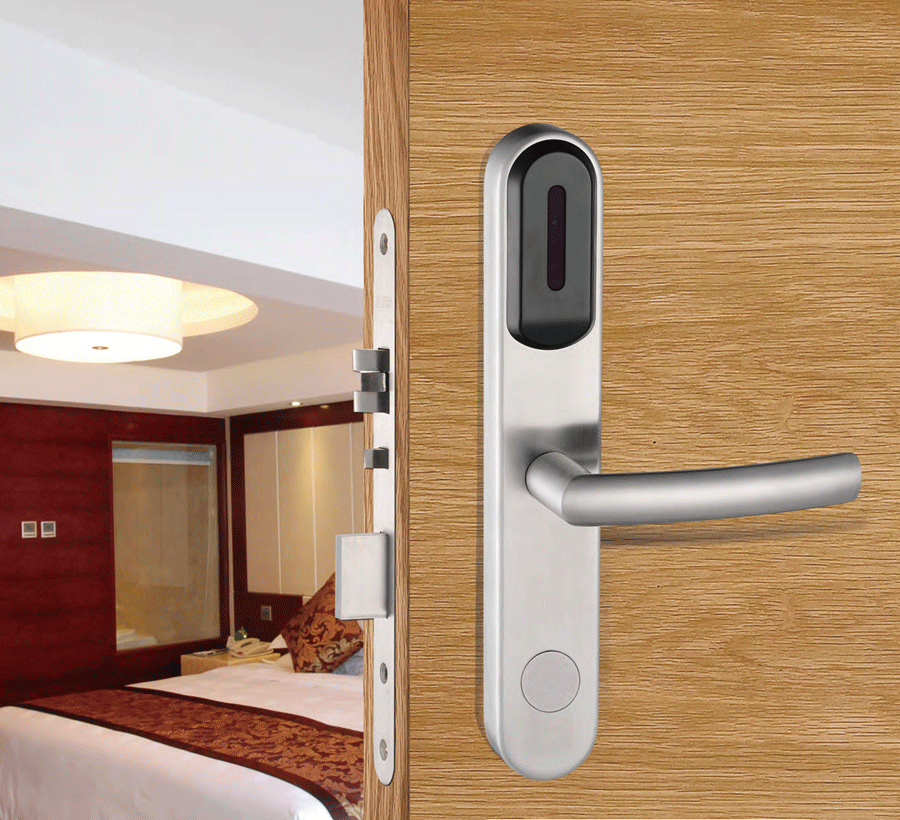
The lock is equipped with many functions and amenities. One of the functions worth mentioning is the ability to set the lock to the "permanently open" position, used, for example, during meetings or conferences. Another advantage of this lock is the do not disturb function. It applies when the hotel guest does not want to be disturbed. In such a case, the room can be opened only with an emergency card, MASTER card or mechanical key. The lock also has an alarm function that warns the hotel staff or hotel guests about an open door. Signaling is done by emitting a sound signal with a red light signal at the same time. This feature prevents any attempted theft or possible intrusions.
The locks we offer can have a modern or classic design. Thanks to this, it allows us to maintain the aesthetics of a given object. Available colors of the locks are satin, gold, brass, brushed brass and copper.
Cards, program and programmer:
For servicing hotel locks, we offer cards with two-sided color printing with standardized dimensions 86x54x0.76mm - the size of an ATM card. All cards are covered with a laminate, which keeps their original appearance for a very long time of use. Cards are printed with the modern inkJet method with very high resolution. For a small surcharge, our graphic design studio also makes a graphic design. The price of the project includes 3 graphic patterns.

Cards are programmed using a programmer, i.e. a special encoder. The device is used to enter and configure cards into the system. It is connected to a computer via a USB port. It is characterized by small dimensions and simple installation. To program a card, put it on the device and set the appropriate function in the program. After completion, the programmer confirms the end of the operation with an optical-acoustic signal. The removal of the card from such a device cannot take place before the recording is completed, which reduces the risk and the number of incorrectly written cards.
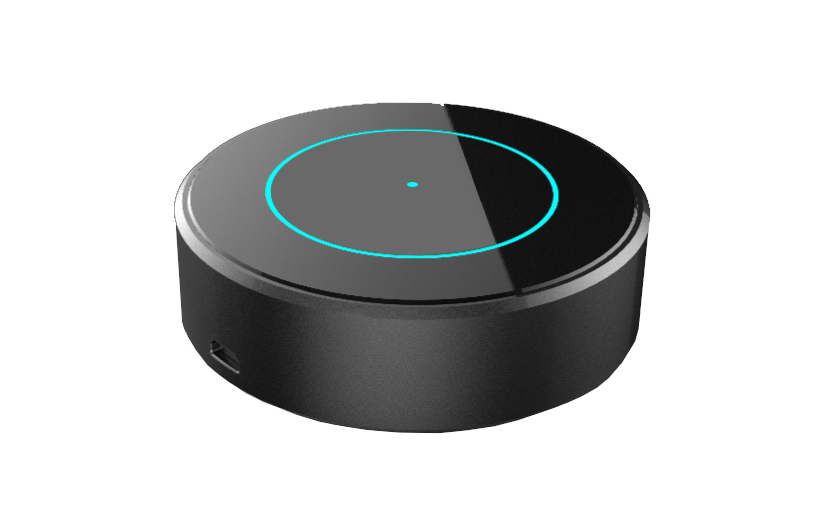
Software V.20/V.30
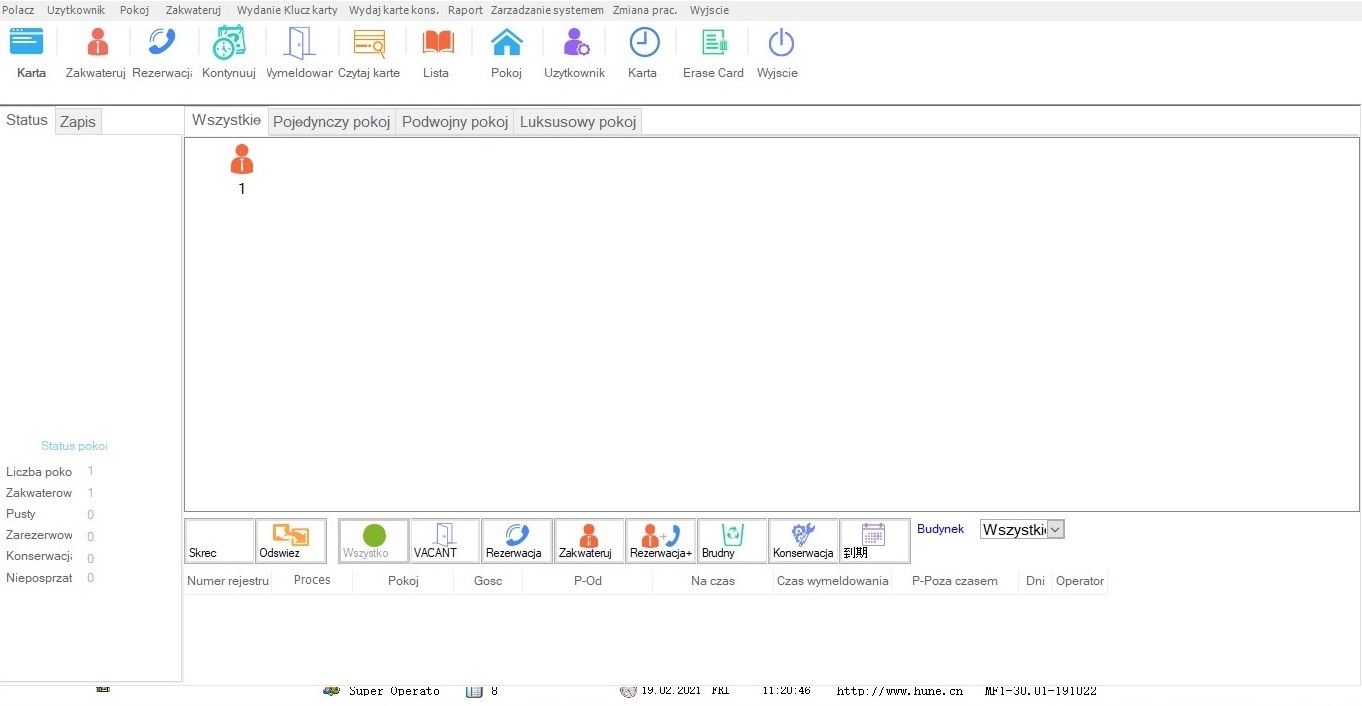
There are 14 types of cards in the hotel lock system:
- System card - the card assigns the lock to the individual system of our facility. This means that cards operating on a similar system, e.g. next to a hotel, will not work in our system
- Lock deletion card - deletes all hotel lock settings
- Program card - assigns the lock number in the system
- Gate card - sets common passages, such as the main entrance to the hotel
- Clock card - sets the time on the locks, it is used when configuring the lock, as well as when replacing the batteries
- Master card - a card that will always open all locks - for the director and people in top positions
- Emergency card - a card that opens individual locks in a given facility in emergency
- Blocking card - the card blocks the guest card lock
- Conference card - sets the lock to conference mode - always open door
- Data card - card for reading events from the hotel lock
- Floor card - the room card opens all locks on a given floor
- Room card - card for the room, opens all locks on the hotel
- Guest card - a card issued to the guest for the duration of his stay
- Spare card - a card issued when a guest card is lost, bringing it closer to the lock causes the removal of the old card and thus activation of a new one
When issuing a card to another customer, a spare card may be generated. In the event of difficulties due to damage or failure of the computer, spare cards can open the door without the need for hotel service cards. If the card is lost or not returned by the hotel guest, the card will be automatically canceled after the time previously specified by the reception has elapsed, it is also canceled with a new card issued for the next user.
Management of the entire system is carried out by a special program. It is an easy-to-use application that can be password protected, has a built-in user manual and context help. This allows us to control the system in a comprehensive way.
Hardware requirements:
- Win XP, XP Profesional XP Home, Vista, Vista BETA, Vista Buisness, Windows 7, Windows 8
- Pentium IV 2 Ghz, 512 MB RAM minimum (1 GB recommended)
- HDD - 50 MB of free space
- USB 1.1 port
- Ethernet network card
- TCP / IP protocol installed
Additionally, it is recommended to perform a daily database backup. Thanks to this, the system can always be restored with an accuracy of several hours back.
Reading data from the lock
The hotel locks we offer have a built-in event memory. Depending on the model, the lock memory can store from 256 to 512 events. After saving all events, the data is overwritten with the oldest one. The data record includes who, when and with what card opened the room, whether there were attempts to open it with a different card, all openings with a mechanical key and many other technical data about the lock itself. The locks work offline, which means that to read the events you have to go directly to the lock and download them to the iRead storage card. By bringing the card close to the reader, the lock transmits data. The data from the card is read using the system programmer attached to the lock service program.
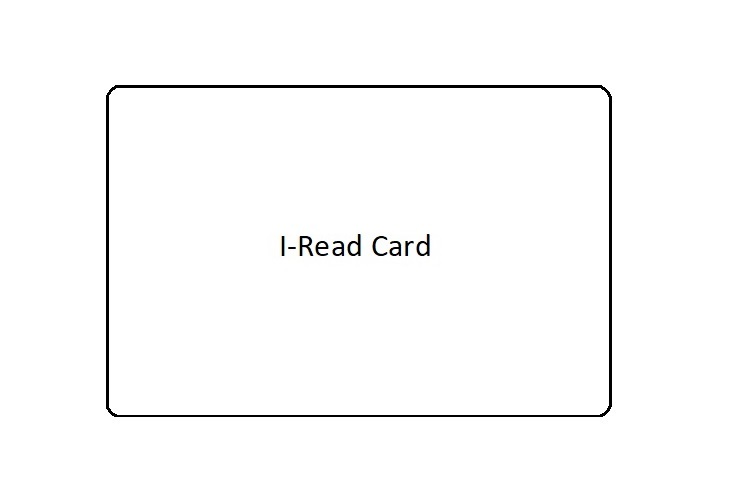
Nie znalazłeś odpowiedzi na swoje pytanie?
Napisz do nas, zadzwoń lub umów się na kawę!
